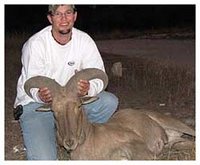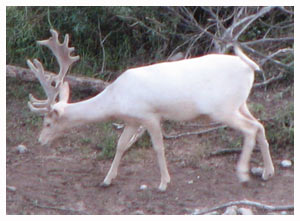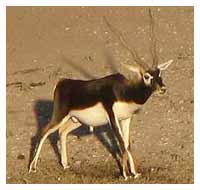Hunting Tips, Questions, Stories & Discussion
Focusing on managing Texas wildlife habitat and natural resources for native and exotic wild game species, for this and future generation of hunters and outdoor enthusiasts.Wednesday, December 31, 2008
What is the average lifespan of the Aoudad Sheep?
 In the wild under good conditions the Aoudad sheep can live to be up to 20 years, longer in captivity. They are very hardy and are not susceptible to the drought and low forage problems that can affect the native species. They can actually go without water for long periods of time and their bodies are able to extract enough water to survive from meager amounts of vegetation.
In the wild under good conditions the Aoudad sheep can live to be up to 20 years, longer in captivity. They are very hardy and are not susceptible to the drought and low forage problems that can affect the native species. They can actually go without water for long periods of time and their bodies are able to extract enough water to survive from meager amounts of vegetation.The main breeding season runs from the first part of September through to the end of November with offspring born from March through to May. Like many species, the Aoudad can breed throughout the year and females will come into season between 18 months and 2 years of age.
Newborn sheep are extremely athletic and can climb around on very rocky and rough terrain
within just a few minutes after birth. The females are very protective of their young and keep them close by until about 4 months of age when they are weaned.
Labels: aoudad hunting, barbary sheep hunting, texas hunting ranch, trophy aoudad sheep
Thursday, December 11, 2008
Fallow Deer: Is there a standard color for this species?
 For many hunters a Fallow deer seems like a bit of a strange species. Most hunters are used to hunting deer and being able to tell immediately what it is because there is only one possible coloration and pattern on the coat. The Fallow deer, however, actually has four separate and distinct color variations. Each is unique in its own way, but they are all the same type and species of deer. There are typically only three color variations seen in Texas and they are described below:
For many hunters a Fallow deer seems like a bit of a strange species. Most hunters are used to hunting deer and being able to tell immediately what it is because there is only one possible coloration and pattern on the coat. The Fallow deer, however, actually has four separate and distinct color variations. Each is unique in its own way, but they are all the same type and species of deer. There are typically only three color variations seen in Texas and they are described below:Melanistic – this is the darkest of the colors. It is an almost pure black coat coloration, sometimes black to very, very deep brown, with a white rump patch. Often this very dark coated Fallow deer is mistaken for a Sika deer at first glance.
White – likely the most commonly seen color variation, white coated Fallow deer are not albinos, they are a true white. The coat can range from a creamy color through to a champagne and white color. Unlike a true albino the eyes and skin are the normal color, not pink like you may expect.
Menil – this color variation includes a darker fawn color with white spots in the summer and a brownish gray coloration during the winter months. The heavier winter coat may retain some of the brown color or may be almost completely gray.
The fourth color variation is lighter than the menil with the spots almost never present during the winter months.
Labels: deer hunting, exotic deer, fallow deer, texas hunting ranch
Sunday, December 7, 2008
What makes Texas a good location for Black Buck Antelope?
 Texas is very similar in many ways to the native range areas of the Black buck Antelope in India and Pakistan. While these locations are not close geographically to each other they still have the same warm summer climates, moderate winter climates and the dryer, lower level rainfalls. In addition the types of grasses and forage is remarkably similar, making an easy transition for the species.
Texas is very similar in many ways to the native range areas of the Black buck Antelope in India and Pakistan. While these locations are not close geographically to each other they still have the same warm summer climates, moderate winter climates and the dryer, lower level rainfalls. In addition the types of grasses and forage is remarkably similar, making an easy transition for the species.It is interesting to note that in India hunting of the wild native Black bucks is now completely prohibited because of the low numbers. Increasing expansion of agricultural and urban areas is destroying much of their range and only isolated pockets of wild herds still exist in the country. Managed Texas areas such as the Escondido Ranch carefully control the numbers hunted per year, ensuring a good population and protection for the species in the state.
How fertile is the species and how hard is it to keep a good sized herd?
The Black buck antelope is a species that breeds year round, although most of the young are born in the spring through fall seasons. With the warmer, milder climates in central Texas even winter born fawns are very healthy and typically survive without any human intervention. Females begin to breed at approximately a year and a half of age, depending on grazing conditions and overall health issues. In managed herds it is possible for females to actually come into season at just over one year.
Black buck antelope fawns are almost always born as single offspring, with a five month gestation period. Since females will breed again typically one to two months after they have the first fawn it is possible for each mature female to produce two offspring per year. Herd managers have to constantly monitor the number of bucks and does within the herd as well as the number of offspring produced. Through good record keeping and monitoring the numbers hunted off any game ranch a standard sized herd the has the best trophy type animals can be maintained year round and from season to season.
Labels: antelope hunting, black buck antelope, texas hunting ranch
Archives
December 2008 January 2009 February 2009 April 2009 May 2009 June 2009 July 2009 August 2009 September 2009 November 2009 December 2009 January 2010 February 2010 March 2010 April 2010
Subscribe to Posts [Atom]
